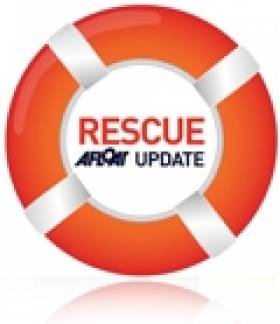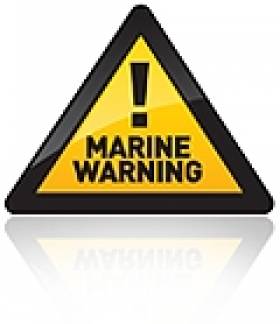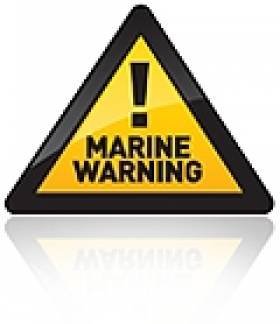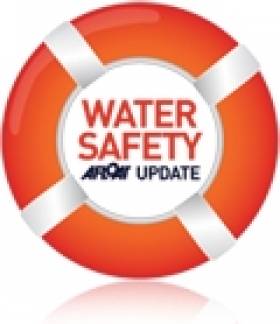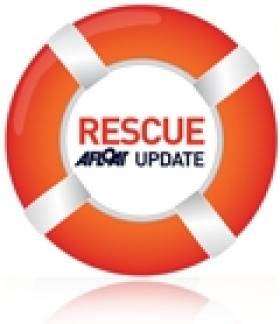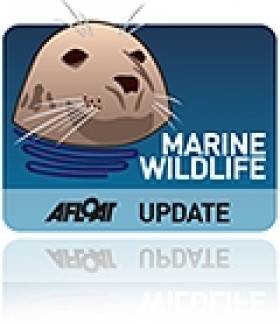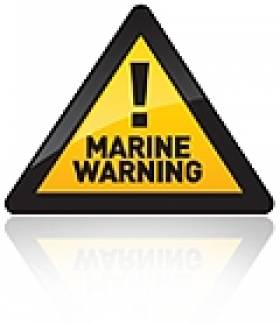Displaying items by tag: Irish Water Safety
Irish Water Safety Launches TV Campaign
Irish Water Safety (IWS) has launched a new TV awareness campaign to highlight best practice whether in, on or around water in an effort to cut the number of tragic drownings on our coasts and waterways.
"Ireland is blessed with some of the most beautiful locations in the world for water based activities and this campaign will help people enjoy these waterways safely," said Minister of State Fergus O'Dowd, speaking ahead of the launch.
The number of people taking to water based activities has exploded in the last decade, says IWS, yet many have had no formal swimming or lifesaving instruction, and many do not know what to do if they or a loved one gets into difficulty in the water.
The campaign highlights the importance of aquiring these skills and others, such as how to correctly wear a lifejacket.
"The most common dangers can be avoided by logging onto Irish Water Safety's website so that when the improving weather prompts a day trip to the seaside, rivers and lakes that you are well informed and stay safe," added Minister O'Dowd.
1,499 Lives Lost in Ten Year Tragic Tide of Drownings
Irish Water Safety is calling for people to be more aware of the dangers presented by water based activities and wants the general public to know that there are many reasons people drown which are not simply limited to warmer weather risk taking. People have a responsibility to themselves and family to stay safe around water by knowing the dangers and learning from the lessons offered by the 1,499 person's lives tragically lost in a ten year period.
A synopsis of some general contributory factors over the years
1. Poor or inadequate equipment (e.g. boats or lifejackets);
2. Alcohol consumption;
3. Falling unexpectedly into water ;
4. Improper use of boats and equipment;
5. Overestimation of skills;
6. Lack of local knowledge when travelling in Ireland and abroad;
7. Not being able to swim;
8. Easy unauthorised access to waterways;
9. Cold;
10. Current (including rip currents, river currents, and tidal currents);
11. Offshore winds (including flotation devices);
12. Pre-existing diseases (e.g. heart attacks);
13. Underwater entanglement;
14. Bottom surface gradient and stability;
15. Waves (coastal, boat);
16. Water transparency;
17. Impeded visibility (including coastal configuration, structures and overcrowding);
18. Lack of parental supervision (infants and children);
19. Change in weather conditions;
20. Excessive 'horseplay' or over exuberant behavior (including "tombstoning" from cliffs);
21. Swimming outside the depth of the user.
22. Suicide and Homicide
A synopsis of some general preventive and management actions
1. Public education by Irish Water Safety regarding hazards and safe behaviours;
2. Teaching children to stay away from water when unsupervised through the IWS PAWS (Primary Aquatics Water Safety) programme;
3. Continual adult supervision of children;
4. IWS media campaigns that drowning can happen quickly and quietly;
5. Promote in IWS press announcements, the restriction of alcohol provision before or during aquatic activities;
6. Provision by Irish Water Safety of properly trained and equipped lifeguards;
7. Provision of rescue services;
8. Irish Water Safety Risk Assessments that include assessments of local hazard warning notices, access to emergency response and availability of resuscitation skills/facilities and other factors;
9. Development by Irish Water Safety of rescue and resuscitation skills among general public and user groups;
10. Coordination by Irish Water Safety with user group associations concerning hazard awareness and safe behaviours;
11. Wearing of adequate lifejackets and Personal Flotation Devices when boating;
12. Fencing and doors to isolate outdoor pools, slurry pits, rivers on farms and other water features near populations.
The 20% decrease in the number of incidents involving leisure and recreational activities to which the Irish Coast Guard had to respond can be accounted for in no small part by the increase in the general public's awareness of water safety best practices. The change in culture on our aquatic environment is comparable to that which saw a huge increase in the wearing of seatbelts in cars over the last two decades. The huge increase in the number of people taking to water-based activities in the last decade saw the culture shift progressively towards a responsibility among the public to wearing lifejackets when taking to water based activities.
Stay Away from the Edge Warns Irish Water Safety
Irish Water Safety is asking people to keep away from the water's edge during the current violent storm force winds and high seas. Ireland averages 153 drownings every year and every year a number of tragedies occur as a result of people walking too close to the edge of coastal areas, cliffs, rivers and lakes during such stormy conditions.
Irish Water Safety is also asking those who own a small craft to make sure that it is well secured and when doing so, to wear a lifejacket at all times as there have been drownings during such activities in the past.
Motorists need to be particularly vigilant to avoid flooded areas on roads but particularly near rivers, because with poor light and short days it is not possible to determine the depth of floods easily. Swift water will carry cars and other vehicles away and there have been very tragic drownings in the past as a result of such accidents.
Children are naturally curious about water, therefore parents should caution them that floodwater hides the true depth and that manhole covers may be open and that small streams when swollen are very fast and deeper than normal.
What should I do when I hear a Flood Warning?
· Listen to the national and local radio for met eireann updates and AA Road watch updates
· Check on neighbours particularly if they are elderly, infirmed or families with young children
· Move your vehicles to higher ground
· Move animal stock to higher ground
· Check your small craft to ensure they are well secured or moored
· Make sure you have warm clothes, food, drink, a torch and radio.
· Block doorways and airbricks with sandbags or plastic bags filled with earth. Floodgate products will work effectively also.
· Switch off gas and electricity supplies if flooding is imminent.
· Check the time of High Water in the Newspaper.
· Check out www.flooding.ie for more detail on General flooding
Personal Safety
· Avoid flood waters at all times
· carry a mobile phone at all times in case you need to call for help - call 112 or 999 in emergency
· Wear suitable protective clothing & a lifejacket in on or around water
· Do not enter fast flowing water.
· Never put your feet down if swept away by fast flowing waters
· Flooding on roads will be deeper at dips and around bridges.
· Stay away from sea and flood defences.
· when walking or driving, be aware of manhole covers and gratings that may have been moved due to the heavy flow of water.
· Take care when using electric appliances in damp or flood conditions.
· Remember that during the hours of darkness the dangers are multiplied.
After the flood
· Avoid eating food that has been in contact with flood water.
· Run water for a few minutes and wash your taps.
· Check gas and electricity supply.
· Leave wet electrical equipment alone to dry and have it checked prior to use.
· Ventilate your property well.
· Check on elderly neighbours.
Flooding Risk - Know How to Stay Safe
Irish Water Safety has today warned about the increased risk to the public in our current and forecast flood conditions. During this coming Sunday afternoon and evening it will become very windy with widespread heavy rain and very strong West to South west winds. There will also be a new moon on Saturday which will bring us large tides and in addition a deep area of low pressure will track over Ireland during Sunday night and Monday and this will further increase the level of tides especially in our estuaries exposed to the south and west coasts. These further periods of heavy rain and south to south west winds will at times increase flooding levels.
Flood conditions expose the public to hazards they need to be aware of. Fast moving water can exert pressure of up to four times its speed against the legs of someone attempting to cross it. Because water displaces bodyweight, the deeper a person becomes immersed the less the person weighs so the more difficult it is to remain upright. Never put ones feet down if swept away in floodwater, because foot and body entrapments and pinning are the leading cause of accidental death in rivers.
Motorists need to be particularly vigilant to avoid flooded areas on roads but particularly near rivers, with poor light and short days it is not possible to determine the depth of floods easily. Swift water will carry cars and other vehicles away and there have been very tragic drownings in the past as a result of such accidents.
Children are naturally curious about water, therefore parents should caution them that floodwater hides the true depth and that manhole covers may be open and that small streams when swollen are very fast and deeper than normal.
What should I do when I hear a Flood Warning?
· Listen to the national and local radio for met eireann updates and AA Road watch updates
· Check on neighbours particularly if they are elderly, infirmed or families with young children
· Move your vehicles to higher ground
· Move animal stock to higher ground
· Check your small craft to ensure they are well secured or moored
· Make sure you have warm clothes, food, drink, a torch and radio.
· Block doorways and airbricks with sandbags or plastic bags filled with earth. Floodgate products will work effectively also.
· Switch off gas and electricity supplies if flooding is imminent.
· Check the time of High Water in the Newspaper.
· Check out www.flooding.ie for more detail on General flooding
Personal Safety
· Avoid flood waters at all times
· carry a mobile phone at all times in case you need to call for help - call 112 or 999 in emergency
· Wear suitable protective clothing & a lifejacket in on or around water
· Do not enter fast flowing water.
· Never put your feet down if swept away by fast flowing waters
· Flooding on roads will be deeper at dips and around bridges.
· Stay away from sea and flood defences.
· when walking or driving, be aware of manhole covers and gratings that may have been moved due to the heavy flow of water.
· Take care when using electric appliances in damp or flood conditions.
· Remember that during the hours of darkness the dangers are multiplied.
Full Moon Prompts Weekend Safety Warning
Spring Tides and an uncertain weather forecast can make this weekend more hazardous than usual.
Irish Water Safety is reminding boaters, sailors, surfers, divers and anglers that there is a full moon on Saturday so they need to be aware of spring tides for the weekend coupled with an uncertain weather forecast.
It is important to take a good weather forecast and to factor this in to their plans accordingly. In addition we wish to remind you of the shorter daylight hours and not to be too ambitious when passage planning over the weekend.
On average 153 people drown in Ireland each year so it is essential to wear suitable protective clothing and a properly serviced and fitted lifejacket when on the water and avoid taking unnecessary risks, especially taking alcohol or drugs as approximately 30% of all drowning victims will have consumed alcohol.
Anglers will be at risk and non nationals in particular should be extremely vigilant as the Atlantic swell is dramatically different to that experienced on the relatively calmer Baltic Sea to which many are accustomed.
It is essential that parents or responsible adults supervise their children at all time when near water.
Walkers should remain alert and stay well away from the edge of ordinarily familiar waterside pathways due to the risk of stranding as a result of the high tides.
Remember your lifeline in an emergency is 999 and 112 therefore carry a mobile phone and ask for the Marine Rescue.
If you discover missing or found Ringbuoys then log on to www.ringbuoys.ie to report them, remember, "a stolen ringbuoy is a stolen life"
International Honour for Irish Water Safety Official
The International Federation Of Swimming Teachers Associations (IFSTA) and Irish Water Safety (IWS) have announced the election of Jim Lawlor of Sligo as President West of IFSTA with responsibility for Europe, Africa, the Americas and Oceania at the World Conference of IFSTA in Holland on Thursday 9th Sept 2010.This position means that Jim Lawlor is also the Senior Vice President of the world body and he will become World President of IFSTA in 2012.
To put this achievement into perspective, a number of facts reflect the importance of IFSTA's contribution to water safety worldwide:
- 1,020,000 Members worldwide;
- 830,000 swimmers trained and certified every year;
- 27,185 Swimming Teachers / Instructors worldwide;
- 10,135 Examiners/ Assessors worldwide;
- 8,000 Swimming Teachers newly trained every year.
Jim is a member of the Council of IWS, a statutory body and he has represented IWS on the world board of IFSTA for five years. He is also Chairman of the Sports Commission within IWS and has chaired the Promotion Commission prior to taking responsibility for Sport.
Congratulations were immediately extended to Mr Lawlor by both the Minister of State at the Department of Environment, Heritage and Local Government, Mr Michael Finneran and also by the Chairman of Irish Water Safety, Mr Frank Nolan, who added that this was a wonderful occasion not only for Mr Lawlor but also for Irish Water Safety.
Speaking after his election, Jim stated that his election was a measure of the esteem in which his colleagues in Irish Water Safety were held by contemporaries around the world and he says he is honoured to have been chosen and he will continue to work with his colleagues worldwide to try to reduce the significant loss of life by drowning over the term of his appointment.
The latest report into worldwide drowning was published by WHO, based on statistics for 2002 and it showed that 403,000 persons drowned in 2002.This equates to 8% of all deaths due to injuries, both intentional and unintentional. The rate per 100,000 of population averaged 6.8 for the whole world but this varied greatly between countries. In some Asian countries the rate is over 10. In Ireland during the 1980s there was an average of over 200 deaths by drowning each year but that has steadily declined to last year's 145 which is a rate of .003%.
This is due to the many programmes promoted by Irish Water Safety which raise public awareness and address the four key issues associated with reducing death by drowning.
1. Removing the hazards - Drain baths, ponds etc
2. Creating Physical Barriers - Fence ponds, Protective Barrier Grills over wells etc
3. Protecting those at risk - Promoting learn to swim schemes such as the IWS PAWS (Primary Aquatics Water Safety), teaching water safety, using trained lifeguards.
4. Countering the damage - Teaching resuscitation
Best Lifesavers in Ireland Set for Donegal Challenge
Ireland's top Lifeguards will compete at Irish Water Safety's National Surf Lifesaving Championships at Rossnowlagh Beach, Donegal from 10.30am to 5pm, Saturday 11th and from 10am-1pm, Sunday 12th Sept.
Hundreds of competitors will gather from counties nationwide and teams of Lifesavers from Wales and Belfast will also compete. Included in the competitors will be the international Irish National Junior Lifesaving team which has just returned from the European finals where the boys came first in all of Europe.
Competitors at the National Championships will have their skills tested in events that simulate emergency swimming rescue scenarios. Teams will fend off strong competition from the fittest Lifeguards nationwide in this gala of lifesaving - the most significant and breathtaking life saving competition in Ireland. Irelands best Lifesavers will contend with the challenging open water conditions on the Donegal coast to rescue potential "casualties" in testing swim races, rescue board races and other events, which culminate in exciting finals throughout the day.
Commenting on the additional challenges of open water competitions, the Chairman of Irish Water Safety's Sports Commission, Jim Lawlor is confident of the team's readiness for the challenge. "Athletes will not only compete with each other while carrying their life saving equipment but also with the open water conditions of Rossnowlagh Beach. Conditions around Ireland's coast are ideal training waters for the teams as they vie for National Championship medals."
The Sport of Lifesaving has been developed to improve the standard of life guarding in Ireland and assist lifesavers save lives. The skills they have honed will demonstrate their lifesaving skills that can be such an important lifeline in an emergency.
As part of its remit to promote water safety in Ireland, Irish Water Safety trains Lifeguards employed at beaches, lakes, rivers and pools nationwide. Irish Water Safety encourages the public to learn to swim and enroll in one of the many courses nationwide in the valuable skills of water survival and lifesaving. Further information on this exciting event is available at www.iws.ie.
Take your family down to these Championships and enjoy a festival of lifesaving that may very well encourage you or a member of your family to learn these lifesaving skills.
This event attracts over 1,000 bed nights in the area in which it is held every year.
Sat 11th Sept 2010, 10.30am - 5pm
Sun 12th Sept 2010, 10.30am - 1pm
Rossnowlagh Beach, Co Donegal
Event Descriptions below.
SURF RACE
With a running start into the surf from the start line on the beach, competitors swim around the 400 m (280 m for Masters) course designated by buoys, returning to shore to finish between the finish flags on the beach.
RESCUE TUBE RESCUE
Four competitors from each team participate in this event: a "victim," one rescue tube swimmer, and two rescuers. The victim swims approximately 120 m to a designated buoy, signals, and waits to be rescued by the rescue tube swimmer. As they return to shore, the remaining two rescuers enter the water to assist. The event finishes when the first competitor in a team crosses the finish line while in contact with the victim.
BEACH FLAGS
From a prone starting position on the beach, competitors rise, turn and race to obtain a baton (beach flag) buried upright in the sand approximately 20 m away. Since there are always fewer batons than competitors, those who fail to obtain a baton are eliminated.
BEACH SPRINT
Competitors take their positions in their allotted lanes. At the starting signal, competitors race the 90 m course to the finish line. The finish is judged on the competitor's chest crossing the finish line. Competitors must finish the event on their feet in an upright position.
BEACH RELAY
Teams of four individuals (three in Masters) compete in baton relay fashion over a 90 m course. To start, two (one and two members in Masters) competitors take positions in their allotted lane at each end of the course. After the start each competitor completes a leg of the course with a baton held in either hand and passes the baton at the conclusion of the first, second, and third legs to the next runner. All competitors shall finish their leg of the event on their feet and in an upright position. Competitors are not permitted to interfere with the progress of other competitors.
SURF SKI RACE
Competitors steady their skis in line in knee-deep water about 1.5 m apart. Competitors must obey directions from the starter or check starter concerning ski alignment at the start. On the starting signal, competitors paddle their skis around the course marked by buoys and return to finish when any part of the ski crosses the in-water finish line - ridden, gripped, or carried by the competitor. Competitors may lose contact and control of their ski without necessarily being disqualified. To complete the race competitors must have (or have regained) their ski and paddle and cross the finish line from the seaward side while maintaining contact with the ski and paddle. Competitors are not permitted to hold or otherwise interfere with other competitors' skis or deliberately impede their progress.
BOARD RACE
Competitors stand on or behind the start line on the beach with their boards 1.5 m apart. At the start signal, competitors enter the water, launch their boards, and paddle the course marked by buoys, return to the beach, and run to cross the finish line. Competitors are not permitted to hold or otherwise interfere with other competitors' boards or deliberately impede their progress.
BOARD RESCUE
In this event, one member of the team swims approximately 120 m to a designated buoy, signals, and waits to be picked up by the second member of the team on a board. They both paddle to shore and cross the finish line on the beach with the board. Competitors must start from the correct allotted position. Competitors swimming to and signalling from the wrong buoy shall be disqualified.
OCEANMAN / OCEANWOMAN
(formerly Ironman / Ironwoman)
Competitors cover a 1400 m (approx.) course that includes a swim leg, a board leg, a ski leg, and a beach sprint finish. Conditions of racing of each leg are as generally required for the individual conditions of that discipline including the rules governing the component disciplines: surf ski races, board races, surf races, beach sprints.
The sequence of legs shall be determined by draw at the commencement of each competition. The same ballot shall determine the order of legs for the Oceanman / Oceanwoman Relay (formerly Taplin Relay). If the surf ski leg is first, competitors will start with a typical in-water start.
Should a bather step on a weever fish then the pain is excruciating as the spines embed into the human flesh and discharge their poison. (SEE RELATED VIDEO BELOW)
The pain is at its most intense for the first two hours when the foot normally goes red and swells up, and then it may feel numb until the following day with irritation and pain that may last for up to two weeks. Sometimes, the spine breaks off in the foot and it will cause discomfort until it is removed. You won't see a Weever fish easily but you will know it's there if you are unfortunate enough to stand on one since its back has a defensive sting mechanism. The sting can be very painful but will not cause permanent damage.
The poison is a type of protein and is heat labile. Most reports of stings occur during the month of August. This does not mean that this fish are particularly prevalent inshore during this month but merely reflects the greater numbers of bathers as the sea temperature reaches the highest of the year. The only death on record after someone being stung by a Weever occurred as long ago as 1927, when an angler suffered multiple stings whilst fishing off Dungeness in the UK.
The mouth itself is in an unusual position on its head, oblique and almost vertical and contains some of the most sharp and vicious looking teeth in the undersea world. Luckily it only reaches about 15 cm long.
The Weever has to be quick to catch is prey though, and for half a metre it has a fair turn of speed, before sinking to the sea floor. This fish does not have a swim bladder, the device used by most bony fish to keep buoyant.
The species found in shallow waters is called the Lesser Weever with the scientific name of Echiichthys vipera. There is a larger species called the Greater Weever, Trachinus draco, found in deeper water and occasionally seen on the fishmongers slab. The word 'weever' was first found used in the English language during the 17th century and comes from the Old northern French word 'wivre'.
One danger is that it can cause anaphylactic shock or allergic reaction and people have been known to die.
People who have been stung should take painkillers and if they develop an allergic reaction to the sting, a course of antihistamines is recommended
Seek assistance from a lifeguard who are all qualified first aiders.
Aspivenin syringes can painlessly draw out poison from the wound.
If you are away from a beach with lifeguard support, as soon as possible get the area which has been stung, invariably the foot, into hot water, this increases the blood flow which assists natural cleaning and healing, the heat also helps to breakdown the poison. The water needs to be over 40 degrees Celsius to be of any benefit in breaking down the poison.
Jedward Backs IWS Safety Message
Jedward is backing Irish Water Safety's mid-summer reminder to the public that with many weeks of warm weather yet to enjoy, everyone can have great fun and do so safely by heeding the following swimming safety tips.
Known for their distinctive blonde quiffs and playful performances, the identical twins singing duo, John and Edward Grimes, performing under the name Jedward have a serious message to fans and parents alike - "Swim at Lifeguarded Waterways this summer - they're all listed on www.iws.ie!

Jedward's Top Tips for Safe Swimming:
1. Swim with others, not alone.
2. Swim parallel and close to the shore within your depth.
3. Never use inflatable toys in open water.
4. Never swim out after anything drifting
5. Pay attention to signs on the beach
6. Never swim in the dark or late at night.
7. Swim in familiar places, avoid strange places.
8. Avoid staying in the water too long
9. Never swim out to sea
10. Do what the lifeguard tells you
11. Don't be a bully
12. Digest food before swimming.
13. Wait a while before swimming if you're hot or tired.
14. Learn to use equipment before trying it out.
15. Learn resuscitation skills.
Use days of inclement weather that keep children indoors as an ideal opportunity for them to learn all about staying safe on Irish Water Safety's website for children, www.aquaattack.ie which is crammed full of games, exercises and advice so that children know how to stay safe in, on and around water.
Water-safety advice that will safe life:
The following rules of water safety may seem familiar, however people often take them for granted and run the risk of tragedy:
- Wear a Personal Flotation Device such as a buoyancy aid or lifejacket. Find out what device suits your needs at www.iws.ie.
- Avoid unsupervised areas. Whenever possible, swim in an area that has a lifeguard. Irish Water Safety has details of all lifeguarded waterways nationwide.
- Stay vigilant abroad. The picture-postcard scenes at venues abroad can often mask hidden dangers. Beaches and swimming pools may not be guarded and warning signs may differ. 17 people drowned whilst on holiday abroad last year.
- Learn swimming and lifesaving. Irish Water Safety has swimming and lifesaving classes for children and adults.
- Take lessons when you try a new water sport. Start your lessons, if they're available, before your trip. Be sure you tell a responsible adult, where you plan to go.
- Never go alone. You'll be safer and have more fun if you pair up with another adult for water sports. If one of you gets into trouble, the other can help - and call for additional help if necessary. Always wear a Personal Flotation Device.
- Watch for changing weather. Be prepared to get out of the water and take cover if the skies look threatening.
- Avoid alcohol. Water sports and alcohol don't mix. Tragically, alcohol is often a factor in adult deaths from drowning or injuries incurred in the water. Alcohol impairs judgment, balance and coordination - all essential for swimming and boating well and avoiding hazards in the water.
- Watch children constantly. Children are irresistibly attracted to water. Take the time to protect your children from the dangers of water.
- Lifejackets Checklist
Visually Check all lifejackets and buoyancy aids for the following deficiencies:
Ensure CO2 Cartridges have not been punctured and are secured firmly
Ensure all zips, buckles, fasteners and webbing straps are functioning correctly and adjusted to fit the user, especially the holding down device or crotch strap
Check that their lights, if fitted are operating correctly
Ensure that Automatic Inflation devices if fitted are fully serviced and in date
Check that the valve or lifejacket is not leaking by inflating the lifejacket overnight
Discard any faulty lifejackets by destroying them
- In Marine Emergencies, call 999 or 112 and ask for Marine Rescue.
Safety Campaign Urges Three Steps to Drowning Prevention
1. SWIM WHERE LIFEGUARDS PATROL - they're trained to keep you safe
Warm summer trips to Ireland's waterways can be an accident waiting to happen if the proper precautions are not taken. One of the safest precautions people can take is to swim at Lifeguarded waterways. Irish Water Safety trained Lifeguards patrol beaches and inland waterways nationwide. Lifeguards are trained to see the dangers develop, can prevent accidents before they happen and respond instantly if they occur. Every year Lifeguards not only carry out all sorts of dramatic rescues but also give on-the-spot advice to keep swimmers. This umbrella of protection is available at Lifeguarded waterways, all of which are listed on Irish Water Safety's website, www.iws.ie.
2. CHECK YOUR LIFEJACKET - it may save your life.
If you have anything to do with boats and being on or near the water, having a lifejacket and wearing it isn't enough - you also have to check that it works. Wearing a lifejacket will only save your life if you know it works so get it checked. That's the pressing message of a Bank Holiday campaign from Irish Water Safety, which is urging people taking to water-based activities to make sure that their lifejackets and buoyancy aids are fully working as they check their equipment ready for the summer season ahead.
Irish Water Safety is concerned about a noticeable increase in the number of people who use Ireland's waterways without wearing proper protective equipment and recommends that all leisure boating enthusiasts wear a lifejacket that is maintained, correctly worn and fit for purpose. More people than ever before are coming into contact with our extensive network of waterways yet tragically there have been a number of drownings this year where the absence of a lifejacket was a contributory cause.
Irish Water Safety has developed a 14-Steps to Safe Boating Guide to educate water users on the dangers that are ever present when boating. SEE BELOW.
3. DROWNING IS FAST AND SILENT - supervise children on holidays.
When the sun is shining and the weather warmer, there's nothing more refreshing than a dip however it is never safe to assume that children will not be injured and this is why water safety must start the moment you arrive at a holiday destination. The swiftness of an accident and its possible outcome is devastating. In the few seconds it takes to turn burgers on the barbecue or dash inside for more cold drinks, a child can drown. The general misconception is that there will be splashing and shouting so parents can come to the rescue. Sadly, this isn't the case. Drowning is fast and silent, which is why many parents don't even know its happening.
Holiday destinations often lull people into a false sense of security and people often put their lives at risk around water as a result of complacency, ignorance of the dangers, a lack of training or a combination of all three. Irish Water Safety has produced the following 14 Steps to safe holidays.
BELOW: Safe Holidays Guide / Safe Boating Guide / Lifejackets Checklist
Irish Water Safety's 14-Steps to Safe Holidays
On arrival at a holiday centre, which has a swimming pool, do not allow children to go immediately to the pool until you have checked out the safety arrangements. On many occasions there may not be any lifeguard on duty.
Swim only after digesting food and never after taking alcohol or immediately after a long journey.
Always swim with others, never alone.
Be particularly careful of young children wandering off. Constantly supervise children/baby pools that may be next to the main pool without any barrier between them.
Check for pool depth markings. There may not be any so you must check the depths yourself if you are a competent swimmer.
Ensure that you do not dive into shallow water.
Watch out for sudden drops or changes in the gradient of a pool floor.
Check for missing, uneven or slippery tiles surrounding or in the pool.
Do not swim or do not allow children to swim in a pool with discoloured water.
Always swim in designated areas patrolled by lifeguards.
Swim with family or friends - never alone.
Swim within your depth and parallel to the shore.
Never swim after dark.
Beware of rip currents, as new moon spring tides are particularly high mid week.
Irish Water Safety's 14 steps to safe and enjoyable boating:
Check condition of boat and equipment, hull, engine, fuel, tools, torch.
Check the weather forecast for the area.
Check locally concerning dangerous currents, strong tides etc.
Do not drink alcohol while setting out or during your trip.
Carry an alternative means of propulsion e.g. sails and oars or motor and oars.
Carry a first aid kit on board and distress signals (at least two parachute distress rockets, two red hand flares).
Carry a fire extinguisher, a hand bailer or bucket with lanyard and an anchor with rope attached.
Carry marine radio or some means of communication with shore.
Do not overload the boat - this will make it unstable.
Do not set out unless accompanied by an experienced person.
Leave details of your planned trip with someone ashore - including departure and arrival times, description of boat, names of persons on board, etc.
Wear a Lifejacket or Buoyancy Aid at all times.
Keep an eye on the weather - seek shelter in good time.
In Marine Emergencies, call 999 or 112 and ask for Marine Rescue.
Lifejackets Checklist
Ensure CO2 Cartridges have not been punctured and are secured firmly
Ensure all zips, buckles, fasteners and webbing straps are functioning correctly and adjusted to fit the user
Check that their lights, if fitted are operating correctly
Ensure that Automatic Inflation devices if fitted are fully serviced and in date
Check that the valve or lifejacket is not leaking by inflating the lifejacket overnight
Discard any faulty lifejackets by destroying them
Always wear a crotch strop on your lifejacket
For information on buoyancy aids and lifejackets click on the IWS website www.iws.ie.




























